By Art Evans | Photos as noted

The Pebble Beach (now expanded) Weekend has become, arguably, the premier vintage automotive event in the U.S. Held each August, it includes not only vintage races at Laguna Seca, but also the Pebble Beach Concours d’Elegance along with a number of other Concours, many auctions and parties, parties, parties.
The Pebble Beach celebration recalls what sports car racing in the U.S. was like during the fifties. It was unique and very different from American circle-track or drag racing of the time. It was also different from previous decades or those that came after.
First of all, it was an amateur sport. But unlike most amateur sports – except perhaps for something like the Olympics and some college sports – it attracted considerable press attention and often thousands of spectators. Many of us raced the cars we drove every day on the street. And most of us drove it to the track and – hopefully – back again. One of the racing rules then was that competing sports cars had to be licensed for the road and include such items as a passenger seat and spare tire.
We raced on temporary circuits like the one at Pebble Beach. This was, after all, road racing. For the most part, our temporary venues were located in or near resorts and sports car racing then was as much a social event as a competition. Today, some of us remember the parties more than the races. Bongo bashes were the cat’s meow. Officials and course workers were all volunteers and events were social for them also.
It was like a fraternity or maybe akin to a military unit that saw combat. Owning a sports car then put us in an exclusive society. When we passed each other on the highway, we would wave. Many of us are still friends years later and we still get together now and then to socialize.
The first Pebble Beach took place on November 5, 1950. The location of the course was on roads within the Del Monte Properties. Much of the Monterey Peninsula is taken up by the Properties, encompassing some 20,000 acres and more than 150 miles of private roads. In addition to hotels, clubs and perhaps more golf courses than people, there are quite a number homes on the Property. It is a gated and privately guarded community. Lots and houses are owned by the residents while all the other land is owned by the Del Monte Properties Company.
While the 1950 Pebble Beach was the first race ever organized by the Sports Car Club of America, it wasn’t the first on the West Coast. To put it in context though, perhaps a little history is in order. The first road race after WWII was held in the small town of Watkins Glen in the Finger Lakes Region of New York on October 2, 1948. The first on the West Coast was in Northern California at Buchanan Field in Concord on November 20, 1949. It was organized, not by the SCCA, but by the Northern California MG Club, headed up by Kjell Qvale. The main event was six laps around a three-mile course laid out on the airfield’s runways. Kjell’s brother, Bjarne (Barney), won, in an MG (of course). The next in the West was at Palm Springs on April 16, 1950, put on by the California Sports Car Club (not then a Region of the SCCA). Sterling Edwards in his Edwards Special won the main event. In May 1950, the MG Club had another race a Buchanan Field and the Cal Club raced at the Santa Ana Blimp Base on June 25.

The Del Monte Properties on the Monterey Peninsula seemed to be to be as an unlikely location for road racing as was Watkins Glen. Wondering how it came about, I contacted my friend, the eminent motorsports historian, Michael Lynch. He told me that one man, Sterling Edwards, was largely responsible. Edwards, a member of the San Francisco Region, was a wealthy heir to a steel-cable manufacturing business. In addition to racing himself, Edwards was interested in race organization. He also constructed a number of cars. The first was the Edwards R-26 Special he made in 1949. It was a ground-up All-American creation with a tubular-steel frame, a light-weight aluminum body and powered by a highly-modified Ford V8-60 engine. It was the car he drove at the two 1950 Southern California races as well as the first Pebble. Sterling continued his car-building efforts with a second special and then he made an attempt at manufacturing a sports car he named the Edwards America. While actually very advanced and attractive for the day, each cost more to make than he could sell them for. So after making five, he gave it up.
Sterling was a close friend of John B. (Jack) Morse, then president of the Properties. The company was trying to attract people to stay at the Del Monte Lodge (now the Lodge at Pebble Beach) as well as sell vacant lots. So Edwards convinced his friend, Jack, to provide the venue. It was a natural fit. A race would generate the publicity desired by the company and the SCCA would have a place to stage events. Sterling was named the chairman of the race committee but because he had entered to race, Kjell Qvale assumed the chair.
Qvale was significant in the development of the sport in Northern California. He was instrumental in organizing the MG Car Club race at Concord in 1949, plus the first Pebble and later, the Golden Gate Park events in San Francisco. A native of Norway, he was born in 1919. In 1929, he immigrated to the U.S., lived through the Depression and became a Navy pilot when WWII came along. Kjell started in the car business with a Jeep dealership in 1946. Later that year, he took a ride in an MG. After a ten-minute spin, he was enthralled. After selling the Jeep dealership, he formed British Motor Car Distributors, LTD in San Francisco and became the Northern California MG distributor. After adding Morris, Riley and Jaguar cars during the fifties, The Qvale Automotive Group became dominant in the Northern California car business.

History of the Pebble Beach Road Races – Page Two
The 1950 Pebble Beach course was laid out entirely within the confines of the Property and, because the land is all private including the roads, any laws of that might prohibit racing didn’t apply. The first course was 1.8 miles in length and was in an irregular rectangle. You can drive it yourself if you wish. The Start/Finish was on Portola Road. All of the turns were right-handers. Proceeding in a clock-wise direction, turn right on Sombria Lane, right on Drake Road, make a sweeping right onto Stevenson Drive and then a sharp right back onto Portola.
The circuit was exceedingly dangerous. Spectators stood or sat right at its edges and trees lined the circuit. In a contest between a car and a tree, the tree was inevitably the victor, often with dire results for the car and sometimes the driver as well. (My close friend, Ernie McAfee, was killed against a tree there in 1956, marking the end of racing at Pebble Beach.) Not only that, the roadway isn’t very wide, so passing was challenging. The 1950 Pebble was organized, as were all subsequent ones at that location, by the San Francisco Region of the SCCA. A crowd of an estimated 10,000 turned out to watch.
That year was also the first for the Pebble Beach Concours d’Elegance. When Edwards and Morse planned the race, they decided to stage a Concours in conjunction. A separate committee was formed to organize the event. The site was a practice tee and driving range on the golf course adjacent to the Del Monte Lodge. A total of 31 entries showed up. They included sports, luxury and antique cars. The oldest was a 1904 Buick. Kjell Qvale entered a 1950 Daimler Drop Head Coupe. Don Parkinson (Jaguar), Bob Gillespie (MG-TC) and Sterling Edwards (Edwards Special) entered the cars they drove in the race. Sterling Edwards won “Best of Show.” All the cars were clean and polished, but not what would today be considered in “Concours condition.”
Technical inspection and practice took place on Saturday, November 4. The first race on Sunday was “The Cypress Point Light Car Race.” It was for SCCA Classes G and F (750-1500cc). All of the 19 starters were MGs except for two Crosley Hot-Shots and an Austin A-40. After the start, Los Angeles attorney Stan Mullin in his MG got into a traffic jam and had to choose between hitting some spectators or a tree. He chose the tree. Although he was not injured, his car was severely damaged. Afterwards, he was awarded the “Best Sportsmanship of the Day Trophy.”

John Von Neumann won in his modified MG-TD followed by two TCs. After the race, he was disqualified for having Methanol in his fuel and for not draining his fuel tank on arrival. Subsequently, he obtained statements to prove that some “pump fuels” also contained Methanol and that many other contestants also didn’t drain their tanks. It’s interesting to note that in an article about the race in the SCCA magazine, SPORTS CAR, Von Neumann is not mentioned and Bill Kerrigan, who finished second behind Von Neumann, is listed the winner. Other accounts, including an article in Road & Track, list Von Neumann as the winner. At any rate, however, John had the distinction of taking the checkered flag in the very first race at Pebble Beach. The Von Neumann MG is now owned by Don Martine and is on display at the beautiful Martine Inn in Pacific Grove (between Monterey and Pebble Beach). Don vintage races it occasionally.

John Von Neumann (1921-2003) was a fascinating character as well as my friend and neighbor. He burst on the racing scene at that first Southern California event at Palm Springs on April 16, 1950. He entered the same car—the modified TD—but blew its head gasket in practice. So he borrowed a Riley for the main event, but ran out of gas. John came from a famous Jewish family (distantly related to the Harvard mathematician). He father was a well-known surgeon in Berlin. But when Hitler came to power, the family fled to Austria and then to the U.S. Young John attended New York University and later transferred to the University of Southern California.
Then the war came along, so John enlisted in the Army and took basic training at the Torrey Pines Army base (where he would later race). After the war, he made his home in Los Angeles, became interested in sports cars and was one of the three founders of the California Sports Car Club. In 1952, he heard that Porsche was making a sports car, so he took the train to New York City, bought one from Max Hoffman and drove it back to California. Von Neumann entered that Porsche in the May 20, 1952 Pebble Beach. Although he failed to finish due a mechanical problem, he led his race—The Pebble Beach Trophy—for a while. His Porsche, the first seen on the West Coast, created a lot of interest. To make a long story short, John went back to New York, bought another Porsche, drove it California and sold it. Eventually, he became a dealer and finally the Western States distributor for both Porsche and VW. He added a Ferrari franchise to his empire and quite successfully raced different models himself. Phil Hill, Richie Ginther and Ken Miles also drove for John during the fifties. In 1971, Von Neumann sold his distributorships to Porsche and VW (they were separate then) and joined the ranks of the super-wealthy.


History of the Pebble Beach Road Races – Page Three
The second event in 1950 was the “Del Monte Trophy,” for Classes D and E (1500-3000cc). The seven starters included the “Edwards Special Sports Roadster,” driven by Sterling, of course. Others included four supercharged MG-TCs. John Edgar entered his supercharged TCs for Bill Pollack to drive. Bill would go on to win the main events at the next two Pebbles.
John Edgar (1902-1972) was one of those fascinating characters who populated the fifties-era sports car scene. John, along with Pollack, was also in the April 1950 Palm Springs. Edgar, the heir to a Ohio manufacturing company fortune, moved to Los Angeles in 1943 and enthusiastically joined the Southern California “car and motorcycle craziness.” His first sports car was a 1947 MG-TC he bought from Roger Barlow’s Los Angeles dealership (where salesman John Von Neumann sold a TC to Phil Hill). Unsatisfied with its performance, Edgar took it to Ernie McAfee, who turned it into a Ferrari-beating hot rod. For the rest of the decade, Edgar became one of the leading wealthy “sportsmen” who sponsored the very best cars and drivers, among them Jack McAfee, Carroll Shelby, Richie Ginther, Pete Lovely and Phil Hill. John’s son, William Edgar, a prolific motorsport journalist, has preserved his father’s legacy.

Pollack drove the Edgar TC in the Del Monte Trophy race. In practice John had Bill use Edgar’s brand-new XK120 because he wanted to save the TC for the race. Pollack’s remembrance of that race was memorialized in American Sports Car Racing in the 1950s (1998 by Michael Lynch, Will Edgar and Ron Parravano): “Ernie had that thing ready to orbit the earth. There were some big Allards and Jaguars ahead of me. When the flag fell, I went up the outside of the pace and was really hauling butt, going by everybody and got out in front. But then, all of a sudden, the car just quit.” Edwards won handily followed by two supercharged TCs.

“The Monterey Unlimited Class Race” was next on the schedule. The “unlimited” meant that it included all cars over 3,000cc. Originally, ten cars were entered, but at the last minute, three were withdrawn. This left three XK120s including those of Phil Hill and Don Parkinson, two Allards, a “Canon” special and an Auburn-Ford. This last was interesting in that it was a 1933 model “Breexymobile” Auburn with a 1937 4-liter Ford engine. Among the Allards was Al Moss in his J2. (Moss started and ran Moss Motors for many years). He was an also-ran in this event, but the next year, he flipped his Allard at Carrell Speedway and never raced again until in vintage some 40 years later. In addition to the Allard, Al had an MG-TC he purchased new and kept for his entire lifetime. He used to drive it from his home in Arizona to Monterey, race in the Historics, and drive it home. A very cautious driver, he always finished dead last.

Michael Graham in his Cad-Allard took the lead and stayed there. Phil Hill, trying to pass, had to take an escape road on the first lap and dropped back to fifth. Back on the road, Phil passed one car after another. At the checker, he was only 10 second behind Graham. During the race, Hill had cooked his clutch. Don Parkinson came in third half a minute behind Phil.
The fourth and final race of the day was “The Pebble Beach Cup,” a 25-lap main event. The field was open to the first four finishers of the previous three races. Not all, however, decided to run. Although he finished only fifth in the second race, Arnold Stubbs was on the grid in his MG-TC with a V8-60 engine (the famous 2Jr). Stubbs was one of the very early Southern Californians who participated with the Cal Club even before that first Palm Springs. (He was Phil Hill’s navigator in the 1952 Mexican Road Race. They finished sixth in a Ferrari). Although disqualified after the Cypress Point event, John Von Neumann entered, so perhaps the SCCA officials had withdrawn the disqualification by then.
A total of 13 cars and drivers sat on the grid waiting for Al Torres to make his run up the side, turn, and drop the flag. Stubbs in his MG took the lead followed by Michael Graham’s Allard and Bill Breeze in his XK120. But on the second lap, Graham made a pit stop for repairs on his cooling system. On the sixth lap, Breeze passed Stubbs and took the lead. By the 11th lap, Phil Hill went ahead and went on to win.


During the time I was writing my book, Pebble Beach Remembered, Phil talked to me about the race. He and his pal, Richie Ginther, modified the XK120 extensively, having enlarged the 3.4-liter engine to 3.8 as well as reducing the overall weight of the car. During the third race, because his clutch had blown, Phil had to shift without it. He and Richie (Phil’s pit crew) didn’t have time to fix it before the main event. He was supposed to start in the middle of the pack, but the only way to get going was to push-start the car. So he started at the tag end. The problem was that when the flag dropped, the engine wouldn’t start. Finally, after a number of push-starts, he was off and passing car after car. At about half way, he was in front. But Richie held out the pit board reading: “Long Lead.” Since Phil didn’t know he was leading, he assumed Richie meant someone name “Long” was ahead. So he pushed harder and harder, trying to catch “Long.” When the checkered flag waved, the engine was starting to overheat and wouldn’t have made another lap. Phil Hill had just won the first important race of his career. He went on to become America’s first World Champion. And 1950, culminating in Pebble Beach, put road racing well on its way to becoming a major factor in U.S. motorsports.
—
I would like to thank John Burkhard, Will Edgar, Michael Lynch and Kjell Qvale for their contributions for this article. If you are interested in more detailed accounts of the races at Pebble Beach, my book, Pebble Beach Remembered (2005) is still in print. Call 800-289-3504. Kjell Qvale is featured in two books written about his life: I Never Look Back (2005) and Lunches with Mr. Q (2002). Bob Devlin wrote Pebble Beach: A Matter of Style (1980). You can probable chase down copies of these two on Amazon as well as American Sports Car Racing in the 1950s.
[Source: Art Evans]


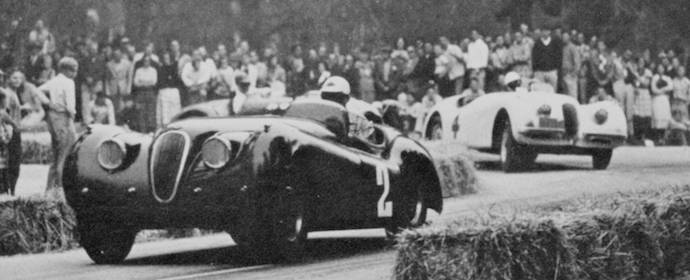

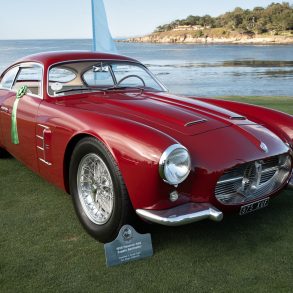
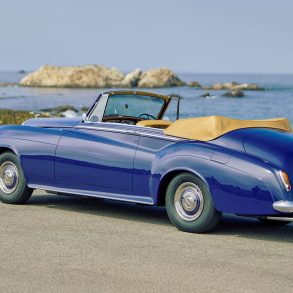
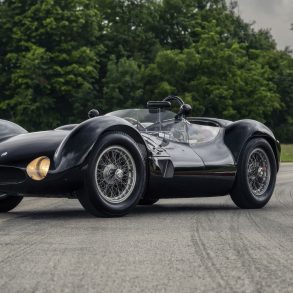

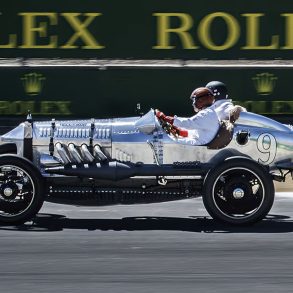


Great nostalgic article – thanks for keeping the memories alive! I wonder what some of these folks think of the 2013 version of “sports car racing” since it is all so serious now?
@Chuck, my dad raced at those races and while todays racing is very serious and money driven, he absolutely loves it and doesn’t miss a race in TV. He doesn’t compare the two though, apples to oranges as far as the the big picture. But out on the track, it’s apples to apples for the driving, which he loves.
He also has movies from those “good ole days” that are a true treasure.
Thanks, Scott, that’s good to hear your dad enjoys today’s action – it stays in your blood I guess. Today’s “track days” or “DEs” are very close in spirit to the 50s races in that many of us still drive our cars to and hopefully from the track and enjoy the camaraderie and friendships as much as the driving challenges. Then it was the Jag 120 and now it is the Vipers or ZR1s that blow your doors off, but we love being there!
Hi Scott, please contact me, I’m producing a documentary on the races.
[email protected]
Fantastic read. Thanks!
Great story Art. You probably know this, but If anyone follows your directions for a drive around the old track, they’ll be doing a slightly abbreviated version. Though much of the original road racing course is remarkably intact, there have been changes to a few of the roads, and to the names of some roads, around the upper parts of the old course. The 1950 race would have gone straight ahead on Drake Road at present-day Stevenson Road, then made the sweeping right onto what is now Forest Lake Road, before coming down the hill to the hairpin right, back onto Portola. Unfortunately, you can’t drive this stretch between Stevenson and Forest Lake anymore. Also, I’m not sure what award Mr. Qvale is presenting in the photo, but it’s certainly not the main event trophy in 1950. The 1950 Pebble Beach trophy was something like 3 feet tall, and was presented to Phil Hill by Mrs. Bjarne Qvale while he sat in the black XK120 just after the race.
Terrific story Art! Thanks. Off to buy a book or 2.
Many of the photos used in this article were taken by Julian P. Graham or someone who worked for him and Graham should be properly credited. Thank you, Barbara Briggs-Anderson, Curator for the Julian P. Graham Historical Photographic Collection, http://www.julianpgraham.com
https://www.youtube.com/watch?v=kn_ID4IbEW4
Nice article Art, thanks for the memories. A friend recently passed away leaving the Bill Kerrigan MGTC from the 1950 race and several extremely low mileage MGs. Any reference material you can recommend would be appreciated by the family and myself.